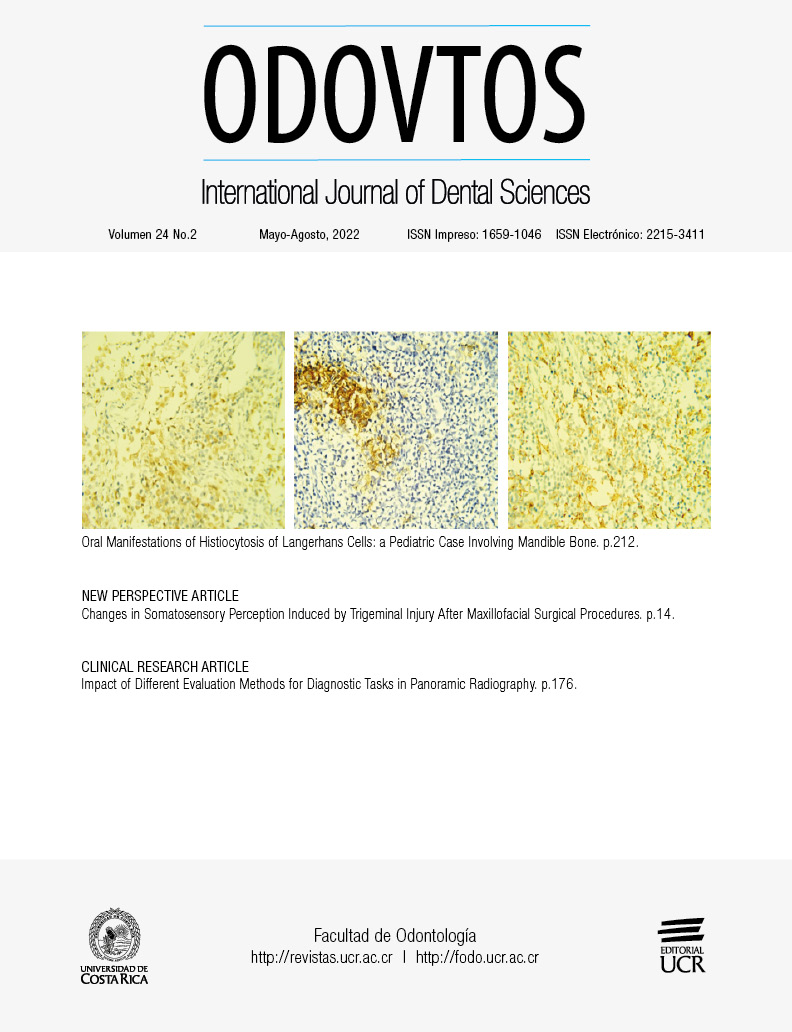Resumen
Este estudio tuvo como objetivo investigar la posibilidad de determinar la edad y el sexo utilizando el diámetro bimastoideo con tomografía computarizada de haz cónico (CBCT). Este estudio retrospectivo investigó a 100 mujeres y 100 hombres de entre 18 y 83 años (edad media: 45,55±16,28 años). Para medir el diámetro bimastoideo, se eligió la imagen adecuada de las imágenes sagital, coronal y axial de CBCT en las que los puntos de medición se podían detectar mejor. La distancia entre los puntos del proceso mastoideo se midió mediante reconstrucción coronal tridimensional. La amplitud media del bimastoide fue de 106,12± 6,22mm. El diámetro del bimastoide en los casos masculinos fue mayor que en los casos femeninos (110,69±4,53 mm frente a 101,65±4,00mm). No hubo diferencias significativas en la amplitud del bimastoide con la edad. Para la determinación del sexo, las mediciones morfométricas del diámetro bimastoide aseguraron una alta tasa de dimorfismo en la subpoblación turca. El análisis morfométrico CBCT puede ser confiable y conveniente para evaluar el sexo y puede recomendarse para comparar datos poblacionales.
Citas
Ekizoglu O., Hocaoglu E., Inci E., Can I.O., Solmaz D., Aksoy S., et al. Assessment of sex in a modern Turkish population using cranial anthropometric parameters. Leg Med (Tokyo) 2016; 21: 45-52.
Manoonpol C., Plakornkul V. Sex determination using mastoid process measurement in Thais. J Med Assoc Thai 2012; 95 (3): 423-429.
Petaros A., Sholts S.B., Slaus M., Bosnar A., Wärmländer S.K. Evaluating sexual dimorphism in the human mastoid process: A viewpoint on the methodology. Clin Anat 2015; 28 (5): 593-601.
Kanchan T., Gupta A., Krishan Kewal. Estimation of sex from mastoid triangle - A craniometric analysis. J Forensic Leg Med 2013; 20 (7): 855-860.
Krogman W.M., Iscan M.Y. The Human Skeleton in Forensic Medicine, Springfield, IL: Charles C. Thomas; 1986.
Kranioti E.F., Iscan M.Y., Michalodimitrakis M. Craniometric analysis of the modern Cretan population. Forensic Sci Int 2008; 180: 110.e1-e5
Saini V., Srivastava R., Rai R.K., Shamal S.N., Singh T.B., Tripathi S.K. An osteometric study of Northern Indian populations for sexual dimorphism in craniofacial region. J Forensic Sci 2011; 56: 700-705.
Ogawa Y., Imaizumi K., Miyasaka S., Yoshino M. Discriminant functions for sex estimation of modern Japanese skulls. J Forensic Leg Med 2013; 20 (4): 234-238.
Grabherr S., Cooper C., Ulrich-Bochsler S., Uldin T., Ross S., Oesterhelweg L., et al. Estimation of sex and age of ‘‘virtual skeletons’’ a feasibility study. Eur Radiol 2008; 19: 419-429.
Dedouit F., Telmon N., Costagliola R., Otal P., Joffre F., Rouge D. Virtual anthropology and forensic identification: report of one case. Forensic Sci Int 2007; 173: 182-187.
Hsiao T.H., Tsai S.M., Chou S.T., Pan J.Y., Tseng Y.C., Chang H.P., et al. Sex determination using discriminant function analysis in children and adolescents: a lateral cephalometric study. Int J Leg Med 2010; 124 (2): 155-160.
Gonzalez R.A. Determination of sex from juvenile crania by means of discriminant function analysis. J Forensic Sci 2012; 57 (1): 24-34.
Günay Y., Altinkök M. The value of the size of foramen magnum in sex determination. J Clin Forensic Med 2000; 7 (3): 147-149.
Tatlisumak E., Ovali G.Y., Asirdizer M., Aslan A., Ozyurt B., Bayindir P., et al. CT study on morphometry of frontal sinus. Clin Anat 2008; 21 (4): 287-293.
Ekizoglu O., Inci E., Hocaoglu E., Sayin I., Kayhan F.T., Can I.O. The use of maxillary sinus dimensions in gender determination: a thin-slice multidetector computed tomography assisted morphometric study. J Craniofac Surg 2014; 25 (3): 957-960.
Yılmaz M.T., Yüzbasioglu N., Cicekcibasi A.E., Seker M., Sakarya M.E. The evaluation of morphometry of the mastoid process using multidetector computed tomography in a living population. J Craniofac Surg 2015; 26 (1): 259-263.
Buran F., Can I.O., Ekizoglu O., Balci A., Guleryuz H. Estimation of age and sex from bimastoid breadth with 3D computed tomography. Rom J Leg Med 2018; (26): 56-61.
Saini V., Srivastava R., Rai R., Shamal S.N., Singh T.B., Tripathi S.K. Sex estimation from the mastoid process among North Indians. J Forensic Sci 2012; 57 (2): 434-439.
Marinescu M., Panaitescu V., Rosu M., Maru N., Punga A. Sexual dimorphism of crania in a Romanian population: Discriminant function analysis approach for sex estimation. Rom J Leg Med 2014; 22 (1): 21-26.
ain D., Jasuja O.P., Nath S. Sex determination of human crania using mastoid triangle and opisthion-bimastoid triangle. J Forensic Leg Med 2013; 20 (4): 255-259.
Steyn M., İşcan M.Y. Sexual dimorphism in the crania and mandibles of South African whites. Forensic Sci Int 1998; 30; 98 (1-2): 9-16.
Walker P.L. Sexing skulls using discriminant function analysis of visually assessed traits. Am J Phys Anthropol 2008; 136 (1): 39-50.
Sakaue K., Adachi N. Evaluation of the sexing methods using the cranial traits in the Japanese population [abstract]. Nihon Hoigaku Zasshi 2009; 63 (2): 125-140.
Cekdemir Y.E., Mutlu U., Karaman G., Balci A. Estimation of sex using morphometric measurements performed on cranial computerized tomography scans. Radiol Med 2021; 126 (2): 306-315.


